Long Division with Remainders
When we do long division, it won’t always result in a whole number.
Sometimes there are numbers left over. These are called remainders.
Let’s take an example similar to that on the Long Division page to make this clearer:
If you’re already comfortable with the process from the Long Division page, you can skip ahead.
 |
4 ÷ 25 = 0 remainder 4 | The first number of the dividend is divided by the divisor. |
 |
The whole number result is placed at the top. Any remainders are ignored at this point. | |
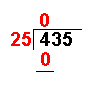 |
25 × 0 = 0 | The answer from the first operation is multiplied by the divisor. The result is placed under the number divided into. |
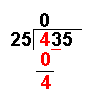 |
4 − 0 = 4 | Now we take away the bottom number from the top number. |
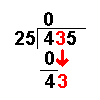 |
Bring down the next number of the dividend. | |
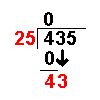 |
43 ÷ 25 = 1 remainder 18 | Divide this number by the divisor. |
 |
The whole number result is placed at the top. Any remainders are ignored at this point. | |
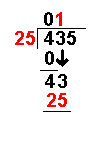 |
25 × 1 = 25 | The answer from the above operation is multiplied by the divisor. The result is placed under the last number divided into. |
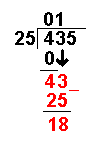 |
43 − 25 = 18 | Now we take away the bottom number from the top number. |
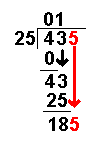 |
Bring down the next number of the dividend. | |
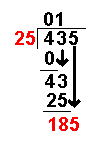 |
185 ÷ 25 = 7 remainder 10 | Divide this number by the divisor. |
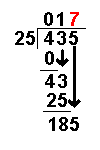 |
The whole number result is placed at the top. Any remainders are ignored at this point. | |
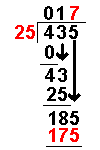 |
25 × 7 = 175 | The answer from the above operation is multiplied by the divisor. The result is placed under the number divided into. |
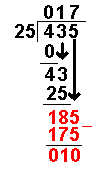 |
185 − 175 = 10 | Now we take away the bottom number from the top number. |
| There is still 10 left over but no more numbers to bring down. | ||
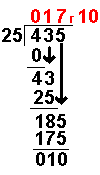 |
With a long division with remainders the answer is expressed as 17 remainder 10 as shown in the diagram
Answer: 435 ÷ 25 = 17 R 10 |
1651, 1652, 1653, 1654, 1655, 1656, 3437, 3438, 3439, 3440
